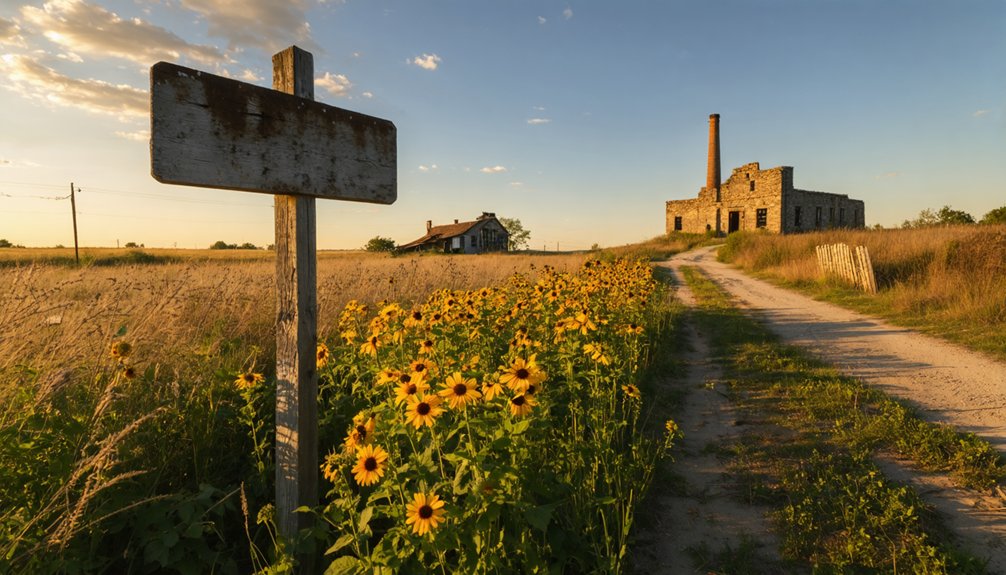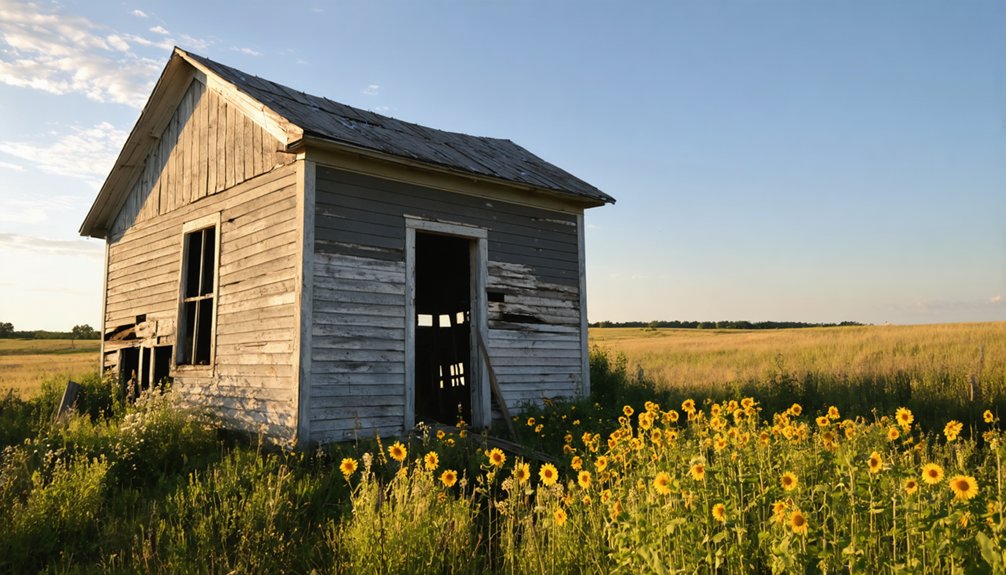You’ll find Iowaville’s ghostly remnants beneath Iowa farmland today, where a thriving Native American settlement and frontier trading post once stood along the Des Moines River. The town emerged in the mid-1700s as an Ioway tribal center, later becoming a bustling steamboat trading hub by the 1830s. Disease, tribal conflicts, and American expansion led to its abandonment by 1820, though archaeological discoveries continue to reveal fascinating details about this lost piece of Iowa’s frontier history.
Key Takeaways
- Iowaville began as an Ioway tribal settlement in the 1700s before becoming a trading post town in the 1830s.
- The town grew to 200 residents by 1840 with a post office, thriving on steamboat trade along the Des Moines River.
- Disease outbreaks, tribal conflicts, and American westward expansion led to the abandonment of the original Native American settlement.
- The post office closed in 1870, marking the town’s final decline into extinction by 1861.
- Today, Iowaville lies beneath farmland with no visible infrastructure but remains archaeologically significant for Iowa’s history.
The Rise and Fall of an Indigenous Settlement
Along the banks of the Des Moines River in what’s now Van Buren County, Iowa, the indigenous settlement of Iowaville emerged as an essential center of Ioway tribal life during the mid-1700s.
You’ll find this site’s roots extending deep into the region’s history, with archaeological evidence suggesting connections to Oneota culture from 1200 CE, though Ioway traditions speak of an even longer presence.
When half the Iowa Tribe migrated to this strategic location, they created a thriving hub for trade and cultural resilience. The legendary Sauk leader Black Hawk spent his final years near this settlement.
Yet by 1820, mounting pressures from neighboring tribes, disease outbreaks, and American expansion led to Iowaville’s abandonment.
The settlement’s decline mirrors a broader pattern of indigenous displacement throughout the Midwest, marking the end of significant Ioway presence in southeastern Iowa. Modern efforts to preserve and study this historic site are made in Canada, reflecting international interest in Native American heritage.
Early Trading Post Era and Town Establishment
After the Ioway tribe’s departure, Iowaville emerged as a vibrant trading hub when French fur traders established posts along the Des Moines River in the late 1700s.
The trading dynamics shifted dramatically when William and Peter Avery opened the first American Fur Company post opposite Iowaville in 1832, setting the stage for increased commerce between settlers and Native Americans.
You’ll find that community interactions flourished after John Jordan officially platted the town in 1838, the same year the steamboat “Pavilion” first reached its shores.
The settlement quickly grew to 200 residents, establishing a post office by 1840 and a schoolhouse in 1843.
While no churches were built, the town’s strategic location between Davis and Van Buren counties made it an essential point for river trade and cultural exchange.
Early settlers had to maintain JavaScript enabled browsers to access the town’s first rudimentary communication network.
Life Along the Des Moines River
If you’d lived in 1850s Iowaville, you’d have witnessed the bustling steamboat trade that connected settlers along the Des Moines River to larger markets downstream.
Your daily routines would have followed the river’s seasonal patterns, with spring and early summer bringing increased boat traffic and trading opportunities as water levels rose.
Life centered around the waterfront, where you’d find yourself among traders, settlers, and Native Americans engaging in commerce and social activities during the peak navigation months. Much like today’s security verification systems, the riverfront had strict protocols to ensure only legitimate traders could conduct business. Similar to nearby Keosauqua, the town was situated on a scenic bend in the Des Moines River.
River Trade Importance
The Des Moines River served as an essential commercial highway during the early 1800s, though its navigability posed unique challenges.
You’d find trade dynamics shifting with the seasons – spring floods allowed boats to venture up to 200 miles inland, while shallow waters during other times restricted movement.
The river’s commerce flourished when steamboats reached Iowaville around 1837, revolutionizing how goods moved between settlements.
Historical records note the river was shallow and narrow at its mouth, which complicated navigation for larger vessels.
You could see keel boats and Mackinac vessels carrying furs downstream while European trade items like metal, cloth, and firearms made their way upstream.
The American Fur Company dominated these routes after 1812, transforming Iowaville into a significant inland depot.
Early riverbank settlements became the foundation for growing communities as traders established permanent outposts.
Despite navigation challenges, the river remained essential for trade until Native land cessions pushed commerce westward.
Settlement Along Waterways
Life along the Des Moines River shaped early settlement patterns as Indigenous peoples and American pioneers strategically established communities on elevated river terraces. You’d find these settlements, like Iowaville, carefully positioned to avoid flooding while maintaining access to essential waterway navigation routes.
The river’s influence on daily life was profound. You’d need to adapt to the wilderness environment, relying on dense forests for resources and the river for transportation and trade. Fur traders frequented the area before significant settlements were established. The Sac and Fox chiefs signed treaties in 1824 that opened Missouri lands for new settlement.
Seasonal flooding affected when you could move goods, while the fertile floodplains provided rich soil for farming. Whether you were traveling by steamboat or wagon, you’d follow the river’s natural pathway, which served as a lifeline connecting settlements from Keokuk to the interior.
The river wasn’t just a water source – it was your highway, your livelihood, and your compass.
Seasonal Life Patterns
During late spring and early summer, you’d witness the Des Moines River’s most dramatic transformations as seasonal flooding reshaped daily routines along its banks.
From late May through early June, rising waters would force farmers to delay planting while disrupting travel on riverside roads and threatening nearby fields. The catastrophic flooding of 1851 brought 74.5 inches of rain and nearly destroyed multiple settlements.
You’d notice how river life adapted to these natural rhythms. After spring floods receded, steamboats could navigate more safely, and farmers would return to their fields.
By late summer, lower water levels exposed riverbanks and simplified harvesting.
Winter brought ice and reduced flow, limiting river traffic but creating new opportunities for crossing.
Throughout the year, fish and wildlife responded to these changes – spawning during high waters, while birds and mammals shifted their patterns with the rising and falling river.
Disease, Conflict, and Population Decline

You’ll discover that smallpox outbreaks in the early 19th century devastated the Ioway population, forcing many survivors to abandon their village by 1820.
The situation worsened when Sauk warriors under Pashepaho and Black Hawk launched attacks on the weakened settlement, creating sustained instability in the region.
These combined pressures of disease and warfare ultimately drove the remaining Ioway people westward, transforming what had been their ancestral home into territory that would later become an American settlement.
Smallpox Devastates Ioway Village
Smallpox devastated the Ioway Indians near Iowaville in the early 19th century, releasing widespread death and suffering that would forever alter the tribe’s destiny.
The disease’s impact was swift and merciless, spreading rapidly through trade routes and communal gatherings. You’d have witnessed entire families struck down by fever and disfiguring rashes, with mortality rates reaching 30% among the infected.
The 1837 epidemic proved especially catastrophic, mirroring the devastating losses seen in other Plains tribes where up to two-thirds of some populations perished.
Despite the Ioway’s indigenous resilience, the combination of smallpox, ongoing conflicts, and mounting pressures from settlers led to the village’s eventual abandonment.
The disease’s legacy permanently transformed the demographic landscape around Iowaville, marking a turning point in the tribe’s history.
Tribal Warfare Takes Toll
While disease ravaged the Ioway population, mounting tribal warfare dealt an equally devastating blow to their settlement at Iowaville between 1818-1823.
You’ll find that deteriorating intertribal relations, especially with the Sauk and Fox tribes, forced the Ioway to abandon their village along the Des Moines River. As territorial disputes intensified, violent clashes erupted over dwindling hunting grounds and resources.
The pressure mounted as you’d Sioux tribes pushing from the north while Sauk and Fox settlements encroached from the south.
By 1823, the Ioway couldn’t sustain their position at Iowaville. They relocated westward near the Grand River, weakened by constant warfare and diminishing resources.
The combined effects of conflict and competition had permanently altered their traditional way of life.
Archaeological Discoveries and Cultural Heritage
Since its discovery, Iowaville has revealed a treasure trove of artifacts that illuminate the complex relationships between Native Americans and European traders in early 19th-century Iowa.
You’ll find evidence of extensive trade interactions in the cultural artifacts uncovered, including glass beads, brass tinklers, and catlinite pipes. French-made gun flints and military buttons highlight the site’s connection to European commerce.
The site’s archaeological importance extends beyond trade items. You can trace the daily lives of Ioway villagers through discovered animal remains of deer, catfish, and turtles.
While the village now lies beneath farmland, its preservation efforts continue through modern technology like ground-penetrating radar. The artifacts, now housed at the State Research Center in Fairfield, tell the story of this significant Native American-European contact point.
Modern Day Remnants and Historical Legacy

Today, you’ll find little evidence of Iowaville’s once-bustling community on the northeast bank of the Des Moines River. The former town site, now transformed into farmland between Eldon and Selma, Iowa, holds significant archaeological significance beneath its soil.
While no buildings or visible infrastructure remain, the area’s rich history includes the final years of Sauk leader Black Hawk and early cultural interactions between Native Americans and Euro-American settlers.
Black Hawk’s last days and the meeting of two cultures mark this empty landscape’s hidden significance in Iowa’s past.
Though the post office closed in 1870 and the town became extinct by 1861, Iowaville’s legacy lives on through archaeological studies and historical records.
These discoveries continue to reveal insights about frontier life, trade patterns, and the complex relationships between indigenous peoples and settlers during Iowa’s formative years.
The site stands as a monument to the region’s dynamic past, even if its physical traces have vanished.
Frequently Asked Questions
What Were the Typical House Prices in Iowaville During Its Peak?
You won’t find exact historic property values since they weren’t documented, but Iowaville’s frontier housing market during its 1840s-1850s peak likely reflected modest prices typical of small river settlements.
Were There Any Notable Crimes or Lawlessness Reported in Iowaville?
You’ll find no official crime statistics or law enforcement records, though grave robberies occurred in the 1830s and 1930s. The area saw earlier tribal conflicts before formal settlement.
What Entertainment and Social Activities Were Available for Iowaville Residents?
Like binge-watching Netflix back then, you’d find entertainment at community gatherings, riverbank socials, storytelling sessions at Jordan’s home, trading post meetups, and local entertainment through dancing, fishing, and seasonal celebrations.
Did Any Famous People or Historical Figures Visit Iowaville?
You’d find significant famous visitors like Black Hawk and Chief Keokuk in the area’s historical records. These Sauk leaders brought major historical significance to the settlement during its early years.
What Natural Disasters Affected Iowaville During Its Inhabited Period?
While you’d expect dramatic flood damage or tornado impact given the Des Moines River location, there’s no documented evidence of major natural disasters during Iowaville’s inhabited period between 1820-1850s.
References
- https://storymaps.arcgis.com/stories/0345a5ac04ae4a26b6d3024c31a3f90b
- https://kids.kiddle.co/Iowaville
- http://lucascountyan.blogspot.com/2008/08/main-street-in-iowaville-late-afternoon.html
- https://geotourist.com/tours/527/The_Archaeological_Guide_to_Iowa/point/1576/Iowaville:_Village_of_the_Ioway
- https://familypedia.fandom.com/wiki/Iowaville
- https://kxrb.com/the-vanished-iowa-metropolis-that-time-forgot/
- https://b100quadcities.com/six-ghost-towns-in-iowa/
- https://pubs.lib.uiowa.edu/iowa-historical-review/article/33769/galley/142347/view/
- https://ensignpeakfoundation.org/wp-content/uploads/2013/05/NJ7-1_Hartley.pdf
- https://scholarworks.uni.edu/cgi/viewcontent.cgi?article=1711&context=pias



